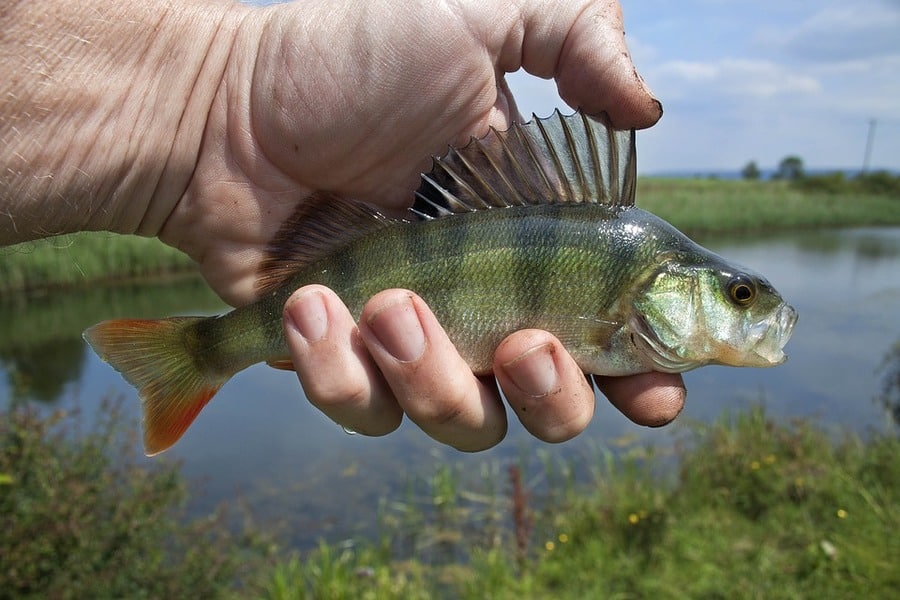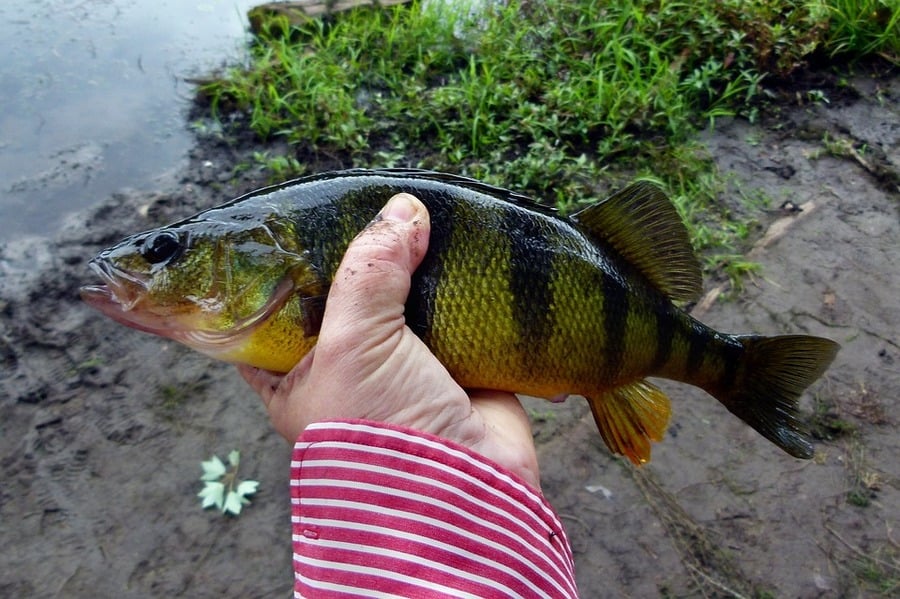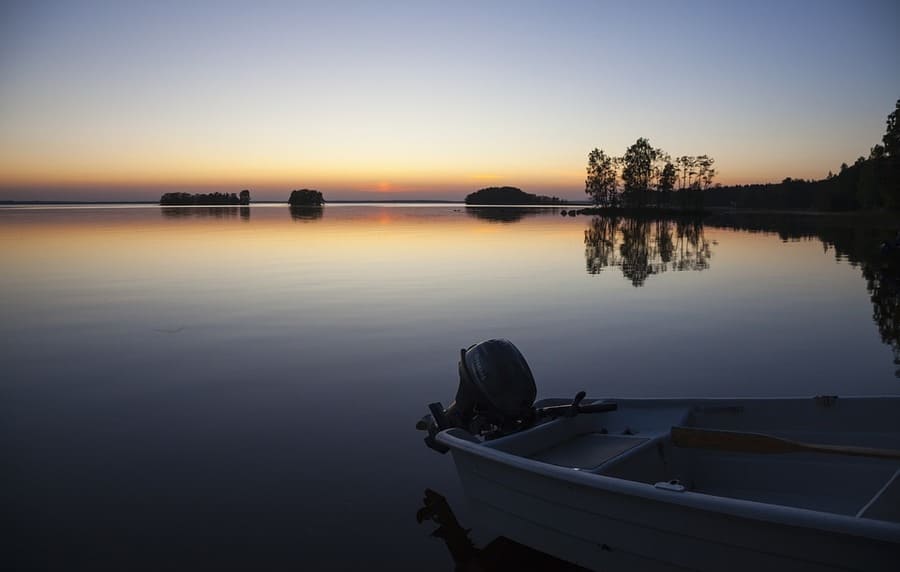Best Time of Day to Catch Yellow Perch: Complete Guide
Leave a comment after this article and let’s talk more about fishing. I’d love to read your feedback.
Yellow perch are one of the tastiest, most sought-after game fish in North America. If you could only spend a few hours on the water, do you know which time of day is best for yellow perch fishing? Depending on the season and conditions, this recommended time window can vary.
What’s the best time of day to catch yellow perch? The best time of day for yellow perch fishing is during daylight hours in the early morning and during the late evening until sunset. It is during these transitional windows when the lower-light mixed with cooler water temperatures gives yellow perch a decided tactical advantage over their prey.
There can be times of the month when nighttime and midday can be the best and I will cover all of these scenarios in this article.
Check out this guide to learn how water temperature impacts yellow perch fishing. We’ll show you how perch fishing is at every temperature range.

Yellow perch are sight-based predators. They require light for their eyes to focus on and perceive prey items and identify potential threats.
The best times to fish for yellow perch most of the time is during the early morning hours of 6 am until 830 am and late afternoon from around 5 pm until sunset.
These are the ‘golden windows’ for perch fishing most of the time. These are the time periods you’ll want to have your baits in the water to catch big yellow perch hungry for food. Yellow perch typically feed once in the morning and once in the evening if food is available.
Midday and nighttime perch fishing is usually pretty weak since perch are so affected negatively by extremes in light availability.
For example, at night there is usually limited or zero available light to guide a perch’s way. This means perch would be hunting nearly blind which is unlikely to result in success and could get the perch eaten.
During the midday, perch are affected by having too much direct sunlight. Yellow perch lack true eyelids so direct light can temporarily blind a perch. This results in perch hunkering down near cover and in the shadows of boats and docks just so they can see.
Granted, there are specific times when midday and nighttime bites can be some of the best for yellow perch. I will expand upon these specific scenarios later in this article.
I recommend getting a lightweight spinning rod for yellow perch fishing. Whether you are fishing with live bait or lures, you want a lightweight rod with fast action and plenty of casting range.
Click here to learn how to catch perch from shore. Learn if yellow perch night ice fishing is good in this helpful guide.
Best Time of Day to Catch Yellow Perch
General Perch Feeding & Activity Tendencies
Yellow perch are active primarily during the daylight hours. Yellow perch along with walleye, bass, pike, and bluegills are predominantly vision-based fish.
This means they rely very heavily on being able to see well in order to track down prey and avoid getting eaten themselves.

The eyes of yellow perch are designed in such a way that they have specialized sensors that help them with depth perception and color differentiation in strong light conditions. They are also designed to absorb greater light which enables them to see prey in lower light conditions.
This combination of factors gives yellow perch a distinct tactical advantage over most prey species, especially insects and invertebrates at the transitional times of day.
This is why early morning and late afternoon are ideal times for perch to feed since the low-light conditions afford them a decided advantage over many of their prey items.
Yellow perch are most active feeding and moving during the early morning and late afternoon hours. For the most part, yellow perch are inactive at night and will hunker down by cover to avoid being eaten themselves.
The full moon, however, does provide enough light for perch to become active feeding during the nighttime hours but the majority of nights, perch will simply be sluggish and timid.
Perch are also sluggish during the midday since they don’t handle direct sunlight well. Yellow perch lack eyelids making it very hard for them to see during the middle of the day. This is why you’ll often see perch in the shadows of docks and boats during this time.
Do Yellow Perch Bite at Night?
Yellow perch are visual predators meaning they rely heavily on their sense of sight to both detect food and avoid predators.
Perch can locate food using other senses but sight makes up the bulk of their guidance. Because of this, yellow perch at least some form of light hitting the surface of the water in order to see.
On most nights, there simply isn’t enough available moonlight to warrant perch becoming active in search of food. Doing so would be a waste of energy with the odds for successfully capturing food is low.
Furthermore, it puts them at greater risk of not seeing bigger predators coming at them. Therefore, most anglers will tell you that nighttime is not a good time to fish for perch unless you are under full moon conditions with limited cloud cover.
Full moonlight from a full moon phase can provide enough light into the upper water column to warrant increased feeding activity by sight-based game fish like yellow perch.
Moonlight lacking in UV light, cannot penetrate far into the water so most feeding activity will occur within 5 feet of the surface.
If yellow perch are going to be caught at night under a full moon, it will be fishing topwater or shallow-swimming baits.
One thing to remember about fishing around full moons with any sight-reliant game fish and not just yellow perch is that the morning after a full moon is usually pretty slow fishing.
Think about it this way, throughout the night, fish were actively feeding and in the early morning light, perch with bellies full of food are not going to feed.
You can still trigger reactionary bites but you’ll need to place your baits right in front of their faces and that has no guarantees. After a full moon, you’re better off waiting until at least late afternoon to start fishing again.
Best Times of Day for Perch: By Season
1. Spring
Best Times: Late Afternoon the best; early morning very good too
In early spring, conditions will more closely match winter than summer. As such, bites will be strongest in the late afternoon since perch are still on that winter-frame of mind.
As the season progresses and water temperature increases, the morning bite will get better and better. By the of spring, the morning bite is rocking and just as good as the evening bite.
Some perch fishermen try to pattern the spawn but I wouldn’t waste your time. The spawn can be very unpredictable and tough to gauge. If you do manage to luck into fishing during the spawn window, late evening into the night is the best time.
2. Summer
Best Times: Early morning & late afternoon equally strong
The warmer temperatures of summer mean fish will be most active along the transitional time frames of early morning and late afternoon. When I say early morning I don’t mean 1 or 2 am.
I’m talking about sunrise until around 8 am. The early hours of daylight. These are the times when the limited light and cooler temperatures give yellow perch a distinct advantage over their prey.
I would avoid midday and nighttime fishing for the most as these simply will result in the slowest fishing. The lone exception when night fishing is good is on full moon nights and for midday is during the middle of a cold spell as midday water temps will rise enough to show a spike in perch activity.
3. Fall
Best Times: Late Afternoon the best; early morning very good too
Fall will mirror spring pretty heavily. Early fall will resemble late summer when early mornings and late afternoons are about equal in terms of productivity. The water hasn’t cooled down substantially yet.
As the season progresses and water temperatures decline, perch will start becoming more sluggish in the morning and really spike up feeding in the late afternoon. 3 pm until sunset will become huge since perch will be packing on pounds for the leaner winter. Fall yellow perch fishing is some of the best you’ll experience all year so take advantage of it.
4. Winter
Best Times: Late afternoon is the best; early morning can be decent
The winter can be tricky to pattern yellow perch. If your body of water does not freeze over, early morning bites can be pretty good with the late afternoon being the best.
In northern states with complete ice cover, the late afternoon is the best time of the day for perch. Ice fishermen do catch nighttime perch on occasion but these are tougher to predictably catch.
Even though yellow perch spent much of the fall bulking up for the lean winter, it doesn’t mean they won’t feed during the winter.
Yellow perch fishing in the winter is usually pretty awesome as long as you can find the schools of hungry perch. Once again, focus most on that late afternoon bite when the water temps are raised.
What’s the Worst Time to Catch Yellow Perch?
In general, the two worst times of day to catch yellow perch is during the midday sun and at night. Yellow perch prefer lower light conditions associated with early morning and late evening hours as this affords perch a vision tactical advantage over their prey.
This is also when water temperatures are a bit cooler which increased both predator and prey activity and feeding opportunities.
During the midday, the overhead sunlight makes it very touch lacking eyelids to see. That is why they hunker real close to cover and remain in the shadows. At night, there simply isn’t enough moonlight to allow perch to see both predators and prey. These are just general rules.

There are exceptions to these rules which I’m about to explain. Midday can be the hottest time to fish for yellow perch when you are in the midst of a cold spell.
Midday spikes in temperature, even by a couple of degrees, can cause perch to become insanely active feeding.
During these days, that midday bites is the best you may experience all day. There are also times when nighttime can be quite good for yellow perch and that is associated with full moon nights.
Full moons can provide some illumination to the upper part of the water column encouraging perch to feed.
Ironically enough, early mornings which is typically one of the best time to catch perch actually becomes the worst time after a full moon since perch will be full from a night of feeding.
Best Time of Day for Perch During the Spawn
Targeting perch around their spawn can be a tricky endeavor. Yellow perch spawn once a year in the springtime when water temperatures reach around 65 degrees F.
Yellow perch will bunch up in very large schools in low-current, shallow parts of lakes or rivers where they are more secluded from larger predatory fish like pike and catfish.
They need this protection since their spawning occurs during the night and early morning when they are incredibly vulnerable to attack.
Yellow perch will actively feed in the hours before and after the spawning event but will be solely focused on reproduction during the spawn itself.
When you are talking about hundreds of perch bunched up in one spot, even though they are not focused on feeding, you are sure to catch yellow perch during the spawn itself.
If you are calculated enough to figure out when the spawning event will occur, I recommend the hours immediately before and immediately after the spawn for the best results. So late evening and early morning will be the best.
What Season are Yellow Perch Most Active at Night?
This is a loaded question as there is no one true season where yellow perch are most active at night. The singular event where yellow perch are active all night long is during the spawn but that occurs one time a year and is very hard to predict. Yellow perch are inactive at night most of the year.
Exceptions to this rule occur on nights of a full moon or near-full moon illumination. The full moon provides some good moonlight which illuminates the upper 5 feet of the water column allowing sight-based fish like perch, bass, and pike a better look at their hunting grounds and the opportunity to sneak up on prey without themselves being spotted.
There will be a couple of nights every month where yellow perch are actively feeding at night and it will be around the full moon. This occurs every season.
Final Thoughts
Yellow perch are heavily reliant upon their sense of vision to both locate food and avoid becoming food themselves.
They have specialized eyes which give them distinct advantages over prey at lower-light conditions around sunrise and sunset. This is why the best time of day to catch yellow perch most of the year is early morning and late afternoon.
